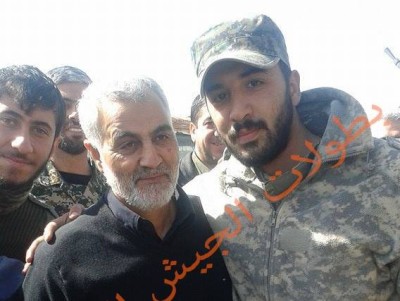PHOTO: Claimed image of General Qassem Soleimani, head of Irans elite Qods Force, in Daraa Province earlier this month
The Assad regime’s counter-offensive south of Damascus continues to grow in significance, even as its outcome is shrouded in confusion.
There was no apparent resolution on Thursday, with both sides continuing to claim victories and capture of territory. However, almost all reports pointed to a high-level effort by Hezbollah and the Iran to take over the fight from Damascus and reverse the insurgent gains of recent months in southern Syria.
Hezbollah and Iranian fighters — rather than the Syrian army — led the battles across southern Damascus and northern Daraa Provinces. Rebel sources say thousands of the foreign troops, joined by Iraqi militias and troops from Afghanistan, are involved.
The evidence raised the possibility that the decision to prop up Assad, with his own regular forces weakened and possibly unreliable, had come at the highest levels of Hezbollah and the Iranian regime. Earlier this week, claims circulated on Iranian social media that General Qassem Soleimani, the head of Iran’s elite Qods Force, had visited Daraa Province recently to assist with the plans for the attacks. If true, the effort replicates Soleimani’s intervention over the last year in Iraq, helping the Baghdad Government push back the advance of the Islamic State.
Victory in the counter-offensive would be as significant as those in Qusayr in 2013, when an influx of Hezbollah troops helped Syrian forces regain the initiative near the Lebanese border, and in the Qalamoun offensive last summer across the south. However, defeat would be a serious blow to the Assad regime, exposing its inability to “win” even with a major intervention by its Hezbollah and Iranian allies.
On Thursday, Syrian State media kept hailing the takeover of the town of Deir al-Addas. Some opposition activists said rebels had retaken the town, while others said the attempts had failed but fighting was continuing just to the west. With no images coming from Deir al-Addas — for example, those of pro-regime TV hailing the triumph — the best assessment was that control had yet to be established.
Battles were reported — often in snow and mud — along a 20-km (12-mile front) for Kafr Nasij, Deir Makir, and al-Habarna, with each side claiming that it had inflicted heavy casualties on the other. Fighting also continued in Habariyah, Himrit, and Sultaniya.
Hezbollah and Iranian commanders are also reportedly involved in attempts by the Assad regime to regain territory in Quneitra Province in southwest Syria.
Last month, an Israeli airstrike killed Hezbollah and Iranian commanders and other personnel in the province, near the Israeli-occupied Golan Heights. Speculation had centered on the possibility that the group was planning the installation of a Hezbollah missile site, but this week’s developments indicate that they may have been scouting the area for the counter-offensive.

